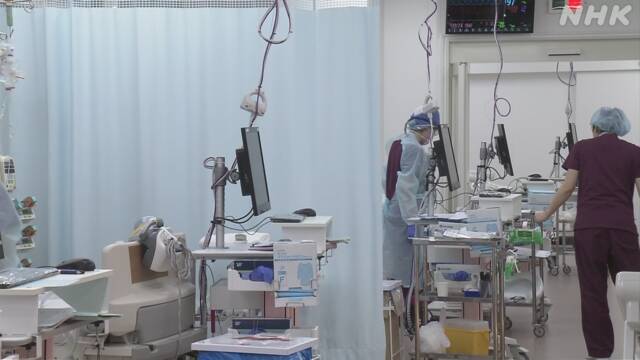With the rapid spread of coronavirus infection in Osaka, the operation rate of severely ill beds exceeded 90% as of the 7th.
Hospitals that treat critically ill patients are raising a sense of crisis that there is a high possibility that patients will overflow as they are.
The Prefectural Nakakawachi Emergency and Critical Care Center in Higashi-Osaka City, Osaka, has secured eight beds for critically ill patients with the new corona, and has treated 122 people so far.
The hospital was once empty of patients in mid-March, but since March 28, acceptance requests have continued every day, and on April 6, all eight beds have been filled and the hospital remains full.
Hitoshi Yamamura, director of the Prefectural Nakakawachi Emergency and Critical Care Center, said, "I feel that eight beds have been filled up in less than a week, with one or two people coming every day. I feel very early. It is very likely that we will run out of severely ill beds in the very near future. "
According to the hospital, the acceptance of critically ill patients in their 40s and 50s, which was rarely seen in the 3rd wave, is increasing, and Mr. Yamamura said, "There are many elderly people in the 3rd wave, and the average age is 70 years old. It was close, but this time the infection has spread to the younger generation, and people who do not have underlying diseases such as diabetes and obesity are becoming more severe. There is a risk of becoming more severe in a wider range of age groups than before. I feel it. "
Furthermore, this time, the length of hospital stay of patients has been extended by an average of 3 to 4 days compared to the third wave.
It is said that the cause is that the value indicating how much antibody against the new coronavirus is present does not rise easily.
It is thought that when the antibody value exceeds 15, the virus is no longer excreted, indicating that the patient is not infectious, but since many patients remain low in the 4th wave, remove the ventilator. It means that the treatment is prolonged because it cannot be done.
"Patients who came after March have very low antibody levels, and it is thought that the virus stays in the body for a longer period of time than in the third wave. It is more difficult to treat than before, apparently 3 The length of hospital stay has been extended by more than 4 days from the day. If the current patient cannot be discharged, he / she will not be able to accept a new one. "
Since this hospital does not have a device to check whether it is a mutant virus, it is not confirmed whether the hospitalized patient is infected with the mutant virus, but due to the characteristics of this patient, Director Yamamura said, "We treat I think that most of the cases of this are mutant strains, at least viruses with different characteristics from the conventional ones, "he said, and realized that the mutant virus might be spreading.
At this hospital, we have newly established a hospital room equipped with a negative pressure device so that we can treat more patients with the new corona.
However, in the current situation where there are only 11 doctors and there are not enough nurses, it is difficult to start a new bed.
Mr. Yamamura said, "The main reason is that there is a clear shortage of nurses and doctors. In addition, although the hospital also provides emergency medical care at the same time, the number of emergency cases has never decreased. However, it is quite difficult to increase the number of beds in the new Corona. However, while the severe beds in Corona are quite tight, there is no choice but to control the beds well while observing the number of emergency patients and patients in the new Corona. ".

